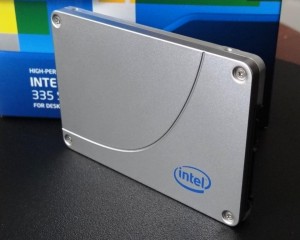 It’s been roughly two years since the SSD industry transitioned to SATA 3 and many believed that Intel had missed the bus. Early leaks of the ‘Intel Road Map’ showed a mere X25 upgrade creating concern as the industry was graduating to SATA 3 and Intel had no 6Gbps design in place.
It’s been roughly two years since the SSD industry transitioned to SATA 3 and many believed that Intel had missed the bus. Early leaks of the ‘Intel Road Map’ showed a mere X25 upgrade creating concern as the industry was graduating to SATA 3 and Intel had no 6Gbps design in place.
Intel jumped back to reality with the ‘Marvel’ based Intel 510 SATA 3 SSD and what we have seen since has been no less than remarkable.
It is almost like the Intel SSD boardroom has been equipped with a healthy stock of Red Bull. Since the 510, we have seen releases of the 320 Series, 710, 520, 330, 910, and today Intel is introducing it’s 330 update, the Intel 335 Series 20nm SATA 3 SSD which is being released in only a 240GB capacity at this point. With an MSRP of only $184, we may soon see 240GB SSD pricing get pushed down to that of the 120/128GB level before you know it. The true question will be whether 20nm horsepower can finally allow for that sweet value/performance handshake the SSD arena has been waiting for.
SPECIFICATIONS AND CONTENTS
Intel 335 Series SSD specifications state that this SSD is capable of 500MB/s read and 450MB/s write with a high count of 52,000 IOPS at low 4K aligned write disk access. As this is a ‘LSI SandForce Driven’ product, our bet is that Intel is being a bit conservative in performance specs and that we will be seeing more typical LSI SandForce speeds. The 335 comes in only a 9.5mm standard size SSD casing and carries a standard three year warranty.
Included in the exterior packaging is the SSD, an external bracket for desktop systems, data and power cables, a Quick Start Guide, sticker, plenty of screws, and a mini-disk that you might think would hold such handy things as the Intel Toolbox and migration software. The mini-disk contains only files that explain the warranty and instructions that provide links to the software download so don’t be so quick to turn off that wi-fi.
COMPONENTS
The exterior of the 335 is of a silver metal casing and secured by four screws that allow access to the printed circuit board (PCB). Unlike others, Intel doesn’t use any abnormal screw configurations or security tape to cover the screws, thus allowing all an easy avenue to check out the 20nm NAND flash memory first hand.

 The PCB contains the LSI SandForce SF-2281 Flash Storage Processor (FSP) and 16 modules of their brand new 20nm synchronous MLC NAND flash memory, eight on each side of the PCB.
The PCB contains the LSI SandForce SF-2281 Flash Storage Processor (FSP) and 16 modules of their brand new 20nm synchronous MLC NAND flash memory, eight on each side of the PCB.
Each module is 16GB in capacity for a total of 256GB, however, LSI SandForce over provisioning is set to 7%, reducing it to the advertised capacity of 240GB. Formatting of the Intel 335 leaves the consumer with an available capacity of 224GB.

 Clicking on any of of our photographs or charts will bring up that of a higher quality. In closer inspection, you might notice that the only change in product numbering between the new 20nm memory used here and the 25nm memory used in the Intel 520 is that the second to last character is an ‘F’ vice ‘E’ (29F16B08CCMF2). Click on the letter ‘F’ to see the Intel 520’s memory.
Clicking on any of of our photographs or charts will bring up that of a higher quality. In closer inspection, you might notice that the only change in product numbering between the new 20nm memory used here and the 25nm memory used in the Intel 520 is that the second to last character is an ‘F’ vice ‘E’ (29F16B08CCMF2). Click on the letter ‘F’ to see the Intel 520’s memory.
 The SSD Review The Worlds Dedicated SSD Education and Review Resource |
The SSD Review The Worlds Dedicated SSD Education and Review Resource | 
From your comments, it seems like this is equivalent in performance to 330 SSD, but the price in not much lower than current prices… in fact, today the 335 is more expensive on newegg than 330! (how does that happen?)… I am sure it will change. Is there something else I am missing on this SSD that makes it better for consumer? Just asking….
Technology is what makes this SSD so interesting. I must admit that I never expected retailers to actually up the manufacturers suggested listed price. For the most part, 20 nm memory increases the potential value and potential size of solid-state drives. Thanks ahead.
agreed, using 20nm is great. IF the price goes down due to 20nm, then it is interesting. So Intel and Plextor are the only companies with 19nm/20nm SSDs now?
BAD DRIVES – Sorry for OT, but Anandtech tested Intel 335 240GB (IMFT 20nm sync):https://www.anandtech.com/show/6388/i…240gb-review/2
“In a few days, I managed to write a total of 37.8TB to the NAND and during that time, the MWI had dropped from 92 to 79. In other words, I used up 13% of the drive’s available P/E cycles. This is far from being good news. Based on the data I gathered, the MWI would hit 0 after around 250TB of NAND writes, which translates to less than 1,000 P/E cycles.”
Is there a reason for using very old Crystal Disk Info for test? Intels 330 shows the Host Write and NAND Write, I ask whether the 335 also can show that?
The latest version of Crystal Disk Info is only a recent release and we will update for future review. Thanks ahead!